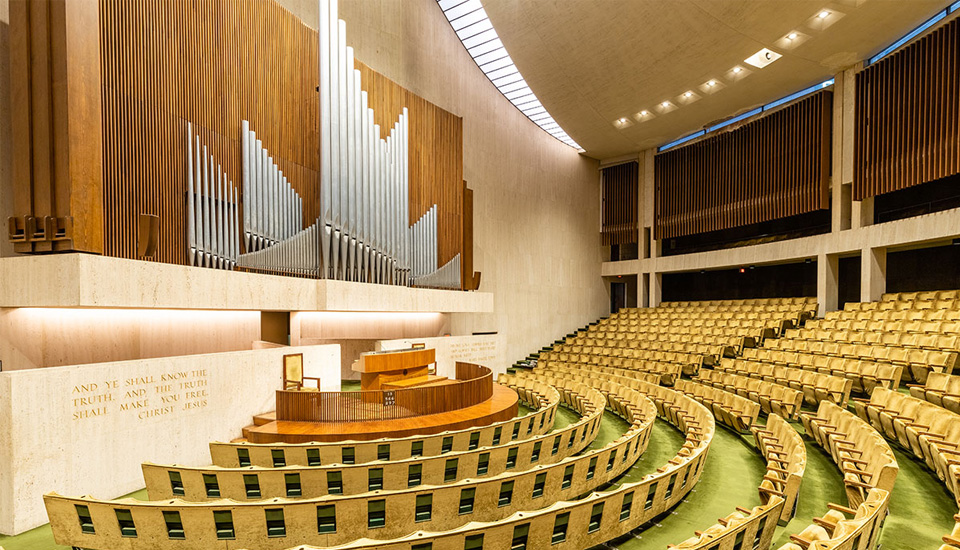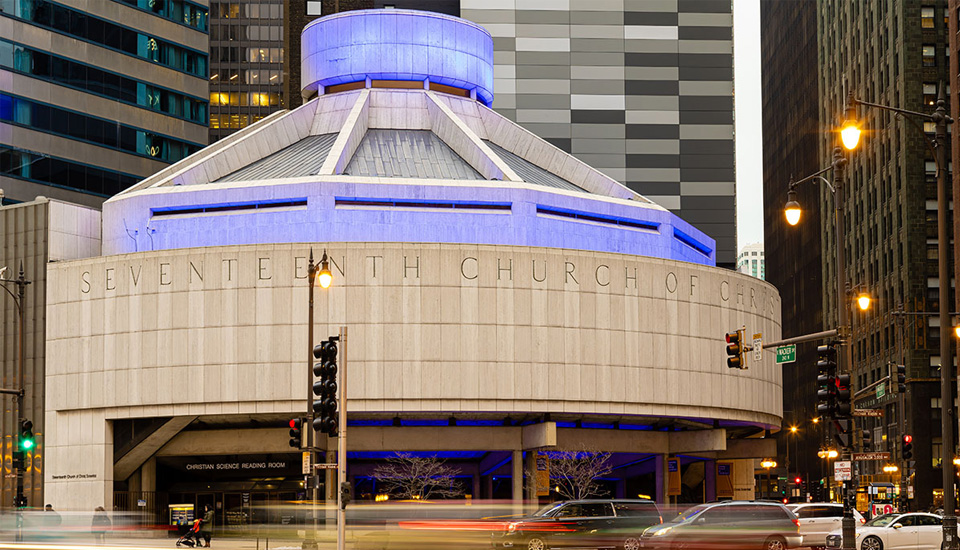ETC puts users first at Seventeenth Church
Date Posted: 5/10/2022

The Seventeenth Church of Christ, Scientist in Chicago is a unique building and a source of pride for its members. Designed by noted architect Harry Weese and built in 1968, parishioners love its unique modernist design and its simple lighting controls.
They loved it so much that even though they knew they needed a lighting upgrade for years they were hesitant to do it. They didn’t want to wreck the spirit of the building or make it harder for the parishioners to operate the lights. Thanks to the design ingenuity of Morlights and the capabilities of ETC architectural
lighting controls, the church now has a state-of-the-art system with effortless controls.
“The Seventeenth Church is an incredibly unique building. It is a huge point of pride for individuals in project,” says Casey Diers, CLCP, a senior designer at Morlights lighting consultancy. Because of the church members’ dedication to the building’s original
look and design, they had resisted calls to upgrade for some time in order to preserve the Weese’s original look and feel of the space.
“They were very concerned about LEDs, fearing a LED luminaire could not provide the warm aesthetic designed in the ‘60s with warm incandescent fixtures.” says Diers. “They were also concerned that any new control system would present an obstacle to use by
members who had been using the original system for over 50 years. They wanted the control system to exactly mimic the original 1968 buttons and sliders.”
But they also wanted to take advantage of the perks of modern fixtures, especially on the exterior of the building. They wanted RGB floodlights and control so they could participate in city-wide lighting events associated with holidays, parades, or sporting
events.
Diers and Morlights came up with a design and system to balance these competing demands. Thanks to ETC’s
Paradigm line of architectural lighting controls and
ColorSource fixtures, the new lighting looks fabulous, has simple controls, and possesses hidden powers.
“The first step to installing a new system was understanding the original Harry Weese design intent,” explains Diers. The main worship space is a semi-circular room. A pipe organ dominates the back wall, with a podium and speaking area centered just in front
of it. The seating area fans out around this central point. Cut-outs in the ceiling provide apertures for ellipsoidal fixtures to light the speaking area, with a wedge of in-ceiling lights running parallel to the back wall in the ceiling.
“In historic photos, the lights graze the wall in an interesting way,” says Diers. “That was a touchstone for our design.”

The team built up a design and did a full-scale mock-up for the client, building out 3D models and renderings to show them exactly how the new design would preserve the original look and feel of the space. The cut-outs in the ceiling were filled with downlights and
ellipsoidal spotlights focused on the podium. For ellipsoidals, Diers chose ETC’s
ColorSource Spot luminaires.
The next step was an on-site demo to give the church an idea of what the design would look like in reality. “We came into the space and set up a series of lights to show not only show the illumination, but also the color and dimming quality. We wanted the client to
be completely comfortable that our design addressed their concerns and preserves the original intent. It is important to give the client an opportunity to react to the new condition before they committing to the installation. With the renovation of a
historical installation such as this one, the clients can’t always fully vocalize detailed lighting feedback, so it is important they have an opportunity to review, at scale and in person, a change before they are committed to it. At this mockup, the only way the client could tell what area
was new was because it was brighter. The new design and fixtures perfectly mimicked the output of the original 300-watt lamps, an element from the original design they could no longer achieve due to energy restrictions on high-power light bulb sales.”
The original controls were also duplicated exactly. A custom ETC faceplate offers users two switches, four faders, and eight buttons that recreate their old controls. Everyone at the church knows exactly what each of the controls do, and how to make the space
look great.
But that’s not where Diers and Morlights stopped. They knew that even though most of the users at Seventeenth Church wanted a dead-simple system, there were times they’d need more. The design team added wireless
Paradigm Handheld Touchscreen stations with custom graphical interfaces for any of the users who wanted more control.
“The Touchscreens have a custom interface that allows users to adjust any and all light settings, including the façade. They can take the wireless station anywhere in the building or even outside to make sure the look is right.”
After the design was approved and budgeted, Diers and Morlights turned into project managers, helping the Church through the bidding process as well as assisting in hiring and managing an installation team. Installation was a breeze because modern fixtures
required so much less conduit than fixtures from the ‘60s.
“We were able to get every single new light running on just a few of the original circuits,” explains Diers. “That left us with a plenty of empty conduits to run DMX through. That alleviated the client’s concerns that we’d have to punch new holes in the walls
to run new infrastructure. Not to mention how much energy savings they will realize moving forward, a benefit that was not an explicit goal of the project, but a welcome improvement nonetheless.”
Being able to run all the control via DMX was a big help on the project and a positive differentiator for ETC. “We were able to keep the system wiring very simple with DMX,” says Diers. “We could send it out via
Gateways using a single cable and opto-splitters where needed. This was great news for the integrator. There are people who say that DMX is too complicated, I have to disagree. DMX is great. It does all of the things that other protocols can’t do. It offers instantaneous control, so for color changing it’s a no brainer.
With DMX you can make color chases that are impossible with any other protocol. A DMX downlight is the same price as any other protocol, with the benefit of all the extra control capabilities.”
DMX also makes the space more attractive to rentals. The space is used rather extensively for rentals. (Most famously in the movie “Divergent” for the “faction choosing” scene.) With a DMX system in control, those rentals can easily mesh with the house network and
lighting. “It was nice to be able to tell the client that it will be very easy for rentals to plug into system and have full control over the luminaires in the space,” says Diers.
Of course, it’s important that the home client loves it, too – and they do. “Everyone loves that it’s out of the way and that it just works all the time exactly the way it has for the past 50 years: A button to turn the lights on, a button to turn the lights off, and
sliders to adjust the levels they touch the most. They needed a system that would cater to needs of a variety of users and they appreciate the fact that
ETC Paradigm lets them do that.”